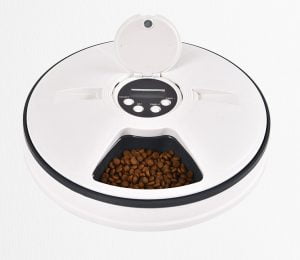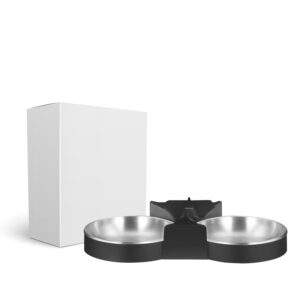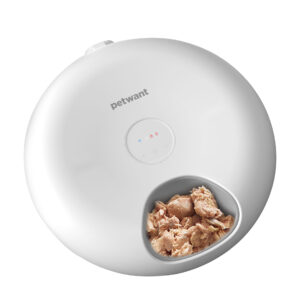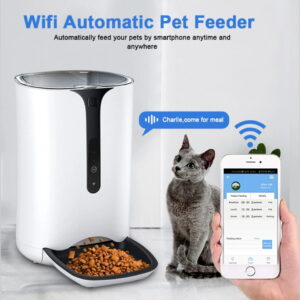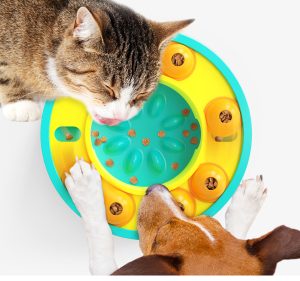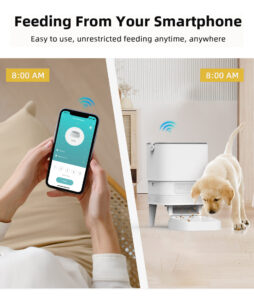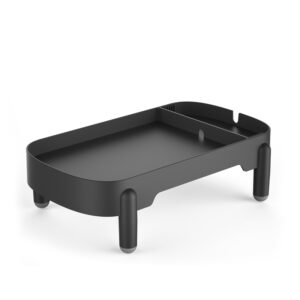Free Feeding vs. Scheduled Meals for Dogs and Cats: Which Is Better?
Not sure whether to leave food out or serve set meals? You’re not alone. Free feeding means leaving food available all day so your pet can eat whenever they want (usually dry kibble). Scheduled feeding means serving measured portions at set times. Below, we compare both for dogs, cats, puppies, and kittens—and offer clear schedules, transition steps, and feeder tips to make the choice easy.
Quick answer:
- Most dogs do best on scheduled meals (especially puppies and dogs in training).
- Most cats thrive on small, frequent scheduled meals—timed feeders make this easy.
- Free feeding can work for a small subset of naturally self-regulating pets, but portion control is essential.
—
What Is Free Feeding for Dogs and Cats?
Free feeding is the “open bowl” approach: food stays down all day. It’s simple and suits some laid-back, single-pet homes.
Pros
- Very convenient on busy days
- Low stress for natural grazers
- Works best for self-regulating pets in single-pet homes
Cons
- Higher risk of overeating and weight gain
- Harder to spot reduced appetite (an early illness clue)
- Tricky in multi-pet homes (food stealing, tension)
- Can encourage picky grazing and boredom eating
Tip: If you free feed, use measured daily portions rather than “bottomless refills.”
—
What Is Scheduled Feeding?
Scheduled feeding means set meal times with measured portions. You can use dry, wet, or mixed diets, and automation keeps timing consistent.
Benefits
- Portion control for healthy weight
- Easier house training for puppies and predictable bathroom breaks
- Clear view of appetite changes
- Adds routine and reduces food anxiety
Potential challenges
- Needs consistency (automatic feeders help)
- Some pets may beg between meals—enrichment and routine help
—
Free Feeding vs Scheduled Feeding: Quick Comparison
- Weight control: Scheduled wins for most pets.
- Convenience: Free feeding feels easier, but automatic feeders make scheduled nearly as simple.
- Behavior and training: Scheduled supports house training, medication timing, and calmer routines.
- Multi-pet homes: Scheduled, supervised meals or microchip feeders prevent food stealing.
—
Best Approach for Dogs
Recommendation: Scheduled meals
Why it works
- Helps prevent overeating and bloaty gulping
- Supports training, impulse control, and predictable potty times
- Makes medications and dental care easier to time
Good exceptions
- Some tiny, high-metabolism or very low-energy dogs can do well with carefully portioned free feeding—monitor weight weekly and adjust.
Puppy feeding schedule
- 8–12 weeks: 3–4 small meals/day
- 3–6 months: 3 meals/day
- 6–12 months: 2–3 meals/day (transition toward 2)
- Adults: 2 meals/day
House training tip: Feed on a schedule, then go outside 10–20 minutes after meals. Consistency speeds success.
Fast eater solutions
- Use a slow feeder bowl or puzzle feeder to reduce gulping and gas.
- How to choose a slow feeder: Pick a bowl diameter close to your dog’s muzzle width; deeper mazes for large breeds, shallow patterns for short-snout dogs.
—
Best Approach for Cats
Recommendation: Small, frequent scheduled meals (timed feeders help)
Why it works
- Mimics natural hunting (4–6 small “prey-sized” meals)
- Controls portions for indoor or overweight cats
- Reduces “3–4 a.m. feed me” wake-ups by pre-scheduling dawn feedings
When free feeding can work
- Naturally lean, self-regulating cats, using measured daily portions. Pair with activity toys to curb boredom eating.
Kitten feeding schedule
- 8–12 weeks: 4 small meals/day
- 3–6 months: 3–4 meals/day
- 6–12 months: 3 meals/day (transition toward 2–3 as adults)
Overweight indoor cats
- Prioritize portion control and 4–6 small meals/day.
- Use puzzle feeders to slow intake and increase activity.
Wet food logistics
- Choose an automatic feeder compatible with wet food (ice pack or cooling bowl) and easy-to-clean parts to maintain freshness.
—
Health Conditions: When the Schedule Matters Most
- Obesity or weight loss plans: Scheduled portions + weekly weigh-ins.
- Diabetes (cats and dogs): Coordinate meals with insulin on a strict schedule—speak to your vet for exact timing.
- Sensitive stomach/IBS: Regular, smaller meals can reduce flares.
- Dental disease: Softened or wet food at set times may be more comfortable than constant dry grazing.
- Food aggression or anxiety: Scheduled, separated feeding areas reduce conflict.
See also: Portion Control: Preventing Obesity in Pets; Hydration Habits: Why Water Matters More Than You Think.
—
7-Day Transition Plan: From Free Feeding to Scheduled Meals
Goal: Move from an always-available bowl to predictable, portion-controlled meals—without stress.
- Day 1–2: Measure your pet’s current 24-hour intake. Divide into 3–4 mini-meals (cats/puppies) or 2–3 meals (adult dogs).
- Day 3: Offer the first day of divided meals at consistent times; remove leftovers after 20–30 minutes.
- Day 4: Reduce between-meal snacking. Add a short play or walk after meals for routine.
- Day 5: Introduce a slow feeder/puzzle for fast eaters. For cats, schedule a small dawn feeding on a timed feeder.
- Day 6: Adjust portions to target calories (ask your vet or use a calculator). Watch stool quality and energy.
- Day 7: Settle into your final schedule. Keep a simple log of appetite, stools, and weight weekly.
—
Multi-Pet Homes: Selective Feeding That Actually Works
- Use microchip/RFID feeders so only the right pet can access the bowl.
- Feed in separate rooms or at staggered times to eliminate food stealing.
- Elevate cat feeders if the dog is the thief.
—
Gravity Feeder vs Automatic Feeder vs Smart Feeder
- Gravity feeder (e.g., AquaMunch Gravity Feeder)
– Pros: Simple, no power needed – Cons: No portion control; not ideal for overeaters or multi-pet homes
- Automatic feeder
– Pros: Timed portions, battery backup options, great for routine – Cons: Less visibility without smart alerts
- Smart feeder (e.g., Cool Bowl Smart Feeder)
– Pros: App control, flexible schedules, portion tracking, camera options – Cons: Needs Wi-Fi/app setup
Helpful CTA: Find the right feeder for your routine and your pet’s eating style.
—
Sample Dog Feeding Schedules by Age (with a 9–5 workday)
Puppies
- 8–12 weeks: 07:00, 12:00, 17:00, 21:00
- 3–6 months: 07:00, 13:00, 19:00
- 6–12 months: 07:00, 18:00 (add a small noon snack if needed)
Adult dogs
- Two meals: 07:00 and 18:00
- Active or underweight? Ask your vet about an extra small midday meal.
Portion guidance: Start with the food label’s daily calories, then adjust weekly based on body condition score. A slow feeder can help enthusiastic eaters pace themselves.
—
Cat Feeding Schedules: Small, Frequent Meals Without Overfeeding
Typical day for indoor adult cats
- 06:00 (timed feeder), 10:00, 14:00, 18:00, 22:00 (optional small portion)
- Aim for 4–6 smaller servings across the day and early morning.
To stop early-morning meowing
- Schedule a 05:30–06:00 automatic meal so your cat no longer associates you with breakfast.
- Add evening play + a small late snack to reduce night waking.
Wet food note: Use a feeder with an ice pack or cooling bowl for morning and evening wet meals; dry meals can fill the midday slots.
—
Automatic and Microchip Feeders: How They Help
What to look for
- Portion control and multiple schedules per day
- App control, feeding logs, and low-food alerts
- Battery backup for power cuts
- For wet food: ice pack/cooling, easy-clean bowls
- For multi-pet homes: microchip/RFID access to prevent stealing
TailMe picks to explore: Classic Connected Feeder Dual Bowls; Wet Pet Food Dispenser; Elegant Connected Auto Feeder; Auto Feeder Stands.
—
FAQs
Is free feeding bad for dogs? Not always, but it’s risky. Many dogs overeat when food is constant, leading to weight gain and missed early illness signs. Scheduled meals with measured portions are the safer default—especially for puppies and dogs in training.
Should I free feed my cat? Only if your cat self-regulates well and you measure the total daily portion. Most cats do better on small, frequent scheduled meals to support weight control and reduce early-morning begging.
How many times a day should I feed a puppy?
- 8–12 weeks: 3–4 meals/day
- 3–6 months: 3 meals/day
- 6–12 months: 2–3 meals/day
Transition to 2 meals in adulthood, adjusting for breed and activity.
Can I free feed wet food? Not recommended. Wet food spoils quickly. If you want more frequent wet meals, use an automatic feeder with an ice pack or cooling bowl and clean it daily.
Do automatic feeders help with pet weight loss? Yes—predictable portions and schedules prevent “top-ups” and reduce begging cues. Choose a feeder with precise portioning and track weekly weight with your vet’s guidance.
Gravity feeder vs automatic feeder: what’s the difference? Gravity feeders refill passively and don’t control portions—fine for rare self-regulating pets. Automatic feeders dispense set amounts on a schedule, which is better for most dogs and cats.
—
Friendly next steps
- Want structure without the stress? Try a smart automatic feeder with portion control.
- Fast eater? Add a slow feeder bowl or puzzle toy to protect digestion.
- Multi-pet juggling act? A microchip feeder keeps everyone on their own plan.
- Prefer a printable? Download the feeding schedule PDF.
- Unsure which feeder fits? Take our 60-second “Find the right feeder” quiz.

